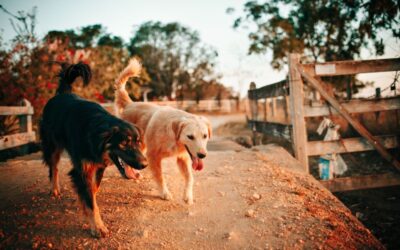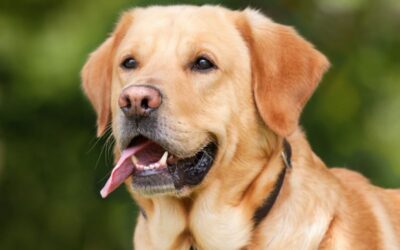Yes, dogs can mate through a fence. Dogs have been known to mate through chain-link fences or other types of fencing if they are able to reach each other physically.
- Understanding Canine Reproduction
- The Mechanism Of Natural Mating
- Debunking The Myth: Dogs Mating Through A Fence
- The Potential Risks Of Mating Through A Fence
- Alternatives To Mating Through A Fence
- Promoting Safe And Successful Breeding
- Frequently Asked Questions On Can Dogs Mate Through A Fence
- Conclusion
However, it is not advisable or safe for dogs to mate through a fence. Mating should ideally occur in a controlled environment to ensure the safety and well-being of both dogs involved. In addition to the risk of injury, mating through a fence can also lead to unwanted litters of puppies if one or both dogs are not spayed or neutered.
Responsible dog owners should take necessary precautions to prevent unplanned or unsafe mating situations.
Understanding Canine Reproduction
Can dogs mate through a fence? Understanding canine reproduction sheds light on whether dogs can successfully mate through a barrier like a fence. Discover the role of physical proximity, social dynamics, and reproductive instincts in this fascinating process.
Can Dogs Mate Through A Fence
Canine reproduction is a fascinating topic that requires a deep understanding of the basic anatomy and physiology of dogs, as well as the reproductive cycle of female dogs and the role of hormones in their reproduction.
Basic Anatomy And Physiology Of Dogs:
- Dogs have a unique reproductive system that consists of both external and internal parts.
- The external parts include the penis (male) and the vulva (female), while the internal parts consist of the testes (male) and the uterus (female).
- During sexual intercourse, the male dog’s penis becomes erect and is inserted into the female’s vulva, allowing for the transfer of sperm.
The Reproductive Cycle Of Female Dogs:
- Female dogs go through a reproductive cycle known as the estrous cycle, commonly referred to as heat.
- This cycle consists of four distinct phases: Proestrus, estrus, diestrus, and anestrus.
- Proestrus is the initial phase where the female attracts males but is not yet ready to mate.
- Estrus is the period of fertility, during which the female is receptive to mating and can conceive.
- Diestrus follows estrus and involves the development of the uterine lining in preparation for pregnancy.
- Anestrus is a resting phase where the female is not receptive to mating and does not exhibit signs of fertility.
The Role Of Hormones In Canine Reproduction:
- Hormones play a crucial role in regulating the reproductive cycle of female dogs.
- Follicle-stimulating hormone (FSH) and luteinizing hormone (LH) are released from the brain’s pituitary gland, stimulating the ovaries to produce eggs and release them.
- Estrogen levels rise during proestrus and estrus, signaling the female’s receptivity and promoting the physical changes necessary for mating.
- Progesterone, produced during diestrus, supports pregnancy and maintains the uterine lining.
- Understanding these hormonal changes is essential for successful breeding and effective contraception.
Canine reproduction is a complex process influenced by the intricate interplay of anatomy, hormones, and the reproductive cycle. By grasping the basic anatomy and physiology, comprehending the reproductive cycle of female dogs, and recognizing the role of hormones, we can gain valuable insights into the fascinating world of canine reproduction.
The Mechanism Of Natural Mating
Dogs cannot mate through a fence due to physical limitations. Mating requires direct physical contact between the male and female dogs.
When it comes to dogs mating, it’s natural to wonder if they can do so through a fence. In this section, we’ll delve into the mechanism of natural mating and provide an overview of canine sexual behavior, focusing on the process of mounting and penetration.
How Dogs Mate Naturally
Dogs have a unique way of mating, and here are the key points to understand:
- Pre-mating behaviors: Before the actual mating process begins, dogs exhibit various behaviors that signal their readiness. These include sniffing the genital area, circling, and vocalizations.
- Mounting: Mounting is the initial step in the mating process, where the male positions himself on the female’s back. This behavior is instinctive and can occur even through a fence.
- Penetration: Once mounted, the male dog attempts to penetrate the female’s vagina using his erect penis. Dogs have a bone in their penis that aids in penetration, allowing it to maintain its rigidity once inside the female.
- Copulatory tie: After successful penetration, the male’s penis swells, forming a knot inside the female’s vagina. This knot temporarily locks the male and female together, preventing premature separation during ejaculation.
- Ejaculation: As the copulatory tie persists, the male ejaculates semen, containing sperm cells, into the female’s reproductive tract. This is a crucial step for successful fertilization.
An Overview Of Canine Sexual Behavior
Understanding canine sexual behavior provides insight into the process of natural mating. Here are the key aspects:
- Estrus cycle: Female dogs experience a reproductive cycle known as the estrus cycle, commonly referred to as being “in heat.” This cycle consists of different stages, including proestrus, estrus, and diestrus. It is during estrus that a female is most receptive to mating.
- Male sexual behaviors: Male dogs exhibit specific behaviors when encountering a receptive female. These behaviors include increased interest, mounting attempts, and sometimes even vocalizations to attract the female’s attention.
- Chemical signals: Dogs rely on chemical signals, known as pheromones, to communicate their reproductive status. Female dogs release pheromones during estrus, which can attract males from a distance.
- Breeding potentials: It’s important to consider individual dogs’ breeding potentials before allowing mating. Factors such as genetic health, temperament, and overall physical condition should be evaluated to ensure responsible breeding practices.
By understanding the mechanism of natural mating and the complexities of canine sexual behavior, we can better comprehend dogs’ mating instincts and the factors involved in their successful reproduction. Remember always to consult professionals and follow responsible breeding practices if you decide to breed your dogs.
Debunking The Myth: Dogs Mating Through A Fence
Dogs cannot mate through a fence due to physical barriers preventing them from engaging in sexual activity. Despite common misconceptions, dogs require direct physical contact to mate successfully.
It is a common misconception that dogs can mate through a fence. However, in reality, this is highly unlikely due to several physical limitations and the role of intimacy and comfort in the mating process. Let’s delve deeper into this topic and assess the feasibility of dogs mating through a fence.
Evaluating The Feasibility Of Mating Through A Fence
- Dogs have anatomical limitations that make mating through a fence highly improbable:
- Male dogs have a penis structure that requires proper alignment for successful mating. The presence of a barrier, such as a fence, can hinder this alignment, making it difficult, if not impossible, for successful penetration to occur.
- The female dog’s anatomy also plays a crucial role in the mating process. The need for proper positioning and receptivity makes it unlikely for mating to be accomplished through a fence.
- Dogs rely on various physical cues during mating:
- The exchange of pheromones between male and female dogs is an essential part of the mating process. These chemical signals are crucial for signaling reproductive readiness and can be affected by a physical barrier.
- Visual and tactile cues, such as body language and touch, are also important for dogs to establish intimacy and initiate mating. These cues are restricted when dogs are separated by a fence.
Assessing The Physical Limitations Of Mating Through A Fence
- Fences create physical barriers that hinder mating:
- Fences, with their solid structure, prevent dogs from achieving the physical proximity required for successful mating. The necessary body positioning and mounting become difficult when dogs are physically separated.
- The presence of a fence restricts the natural movements and freedom required by dogs to navigate and establish successful mating positions.
- Dogs require a spacious environment for mating:
- Dogs need ample space to move around and establish a comfortable physical connection during mating. The confined space created by a fence may result in discomfort and hinder their ability to mate.
Understanding The Role Of Intimacy And Comfort
- Mating is a sensitive and intimate act for dogs:
- Intimacy and comfort are crucial factors in the mating process. Dogs require a level of trust and emotional connection to engage in successful reproduction. The presence of a fence can disrupt this intimacy, making it challenging for dogs to establish the necessary emotional bond.
- Fences can create anxiety and stress:
- Dogs may experience anxiety and stress when confined by a fence, which can negatively impact their ability to engage in mating behavior. Comfort and relaxation are vital for dogs to enter into the mating process.
The idea of dogs mating through a fence is merely a myth. The physical limitations, lack of proper positioning, and the importance of intimacy and comfort make it highly improbable for dogs to mate in such circumstances successfully. It is essential to provide dogs with a suitable environment and remove any barriers to a successful mating experience.
The Potential Risks Of Mating Through A Fence
Mating through a fence can pose potential risks for dogs, including injuries, discomfort, and frustration due to restricted movement and limited contact. It is important to supervise and prevent such encounters to ensure the safety and well-being of your pets.
Mating through a fence may seem like a convenient option for dog owners, but it comes with several potential risks and drawbacks that should be carefully considered. This practice can pose dangers to the dogs involved, both physically and emotionally.
Additionally, it may have negative consequences for the female dog’s health. Let’s explore these risks further:
The Dangers Of Hindrance And Injury
- Mating through a fence can hinder the natural mating process, which involves both dogs freely moving and positioning themselves. This hindrance can affect the success of the mating, potentially leading to unsuccessful or incomplete mating attempts.
- The fence itself can pose a risk of injury to the dogs. Sharp edges, protruding nails, or even the dog’s own attempts to push through the barrier can result in cuts, scratches, or other injuries. These injuries can cause pain, discomfort, and potential complications.
- In some cases, the dogs may become caught or stuck in the fence while attempting to mate. This can lead to panic and anxiety, as well as physical harm if they struggle to free themselves. It is important to note that such incidents can cause trauma to the dogs, affecting their future mating behavior.
The Psychological And Emotional Impact On Dogs
- Mating through a fence can cause confusion and frustration for the dogs involved. They rely on a series of visual cues, body language, and physical interaction during mating to establish a bond and ensure successful reproduction. The barrier created by the fence can disrupt this natural process, resulting in heightened stress and anxiety.
- Dogs may experience heightened territorial behavior when attempting to mate through a fence. This can lead to increased aggression or even fighting between the dogs. It is crucial to consider the potential impact on their mental well-being and overall temperament.
Consequences For The Female Dog’s Health
- Mating through a fence can potentially increase the risk of injury to the female dog’s reproductive organs. The forceful attempts to position and align through the fence can cause trauma to the delicate tissues and organs involved. These injuries can range from mild discomfort to serious complications that require veterinary attention.
- The female dog may also face an increased risk of infection when attempting to mate through a fence. The presence of external debris, such as dirt or bacteria on the fence, can introduce harmful pathogens into the reproductive tract. This can lead to various infections, including but not limited to vaginitis or pyometra.
- Additionally, the hormonal and physiological changes associated with mating can be affected when dogs are unable to engage in the natural mating process fully. These disruptions can impact the female dog’s reproductive health, potentially leading to irregular heat cycles or fertility issues.
While mating through a fence may appear to be a convenient solution, it carries potential risks and negative consequences. It is essential to prioritize the safety, well-being, and overall health of the dogs involved.
Alternatives To Mating Through A Fence
Dogs cannot mate through a fence, as the physical barrier prevents full contact between them. However, there are alternative ways for dogs to interact and mate safely, such as controlled introductions and supervised playdates.
When it comes to dog breeding, responsible dog owners must be aware of proper practices and alternatives to mating through a fence. It is crucial to ensure controlled and supervised mating to prioritize the health and well-being of the dogs involved.
In this section, we will explore recommended breeding practices and introduce the concept of artificial insemination in dogs as an alternative method.
Recommended Breeding Practices For Responsible Dog Owners:
- Take the time to find the right mate: Carefully select the mate based on health, temperament, and breed standards.
- Conduct health screenings: Prioritize the health of both the male and female dogs by conducting thorough health screenings to identify any underlying genetic or hereditary conditions.
- Schedule a pre-mating veterinary check-up: Before breeding, take both dogs for a veterinary check-up to ensure they are in good overall health and free from any underlying health issues.
- Ensure a safe and controlled environment: It is important to provide a safe and comfortable space for the dogs to mate. Consider using a clean and suitable breeding area instead of relying on the fence as a mating surface.
- Supervise the mating process: Supervision is crucial during the mating process to prevent any injuries or aggressive behavior. Responsible dog owners should be present to monitor the dogs and intervene, if necessary, closely.
The Importance Of Controlled And Supervised Mating:
- Dogs mating through a fence can be dangerous as it can lead to injuries, entanglement, or potential escape. By ensuring controlled and supervised mating, you can minimize the risks involved and protect the well-being of both dogs.
- Controlled mating allows for proper timing and duration, ensuring successful breeding while reducing any potential stress, discomfort, or trauma to the dogs.
- Supervision during the mating process allows for immediate intervention in case of any complications or aggressive behavior. This ensures the safety of the dogs and increases the chances of successful mating.
Introduction To Artificial Insemination In Dogs:
- Artificial insemination is a viable alternative to traditional mating for various reasons, including distance limitations, health concerns, or behavioral issues.
- This technique involves collecting semen from the male dog and manually implanting it into the female’s reproductive tract, bypassing the need for direct physical contact or mating through a fence.
- Artificial insemination provides a controlled and monitored approach to breeding, ensuring precise timing and reducing the risk of injury or stress for the dogs involved.
- Additionally, it allows for the preservation and utilization of quality genetic material from valuable stud dogs, even if they are not physically present.
By following these recommended breeding practices and considering alternatives like artificial insemination, responsible dog owners can prioritize the well-being of their dogs while ensuring successful and controlled breeding. Remember, the health and safety of dogs should always be at the forefront of any breeding decisions and practices.
Promoting Safe And Successful Breeding
Dogs cannot mate through a fence due to physical barriers preventing successful breeding. Understanding safe breeding practices is crucial for dog owners to ensure the health and well-being of their pets.
The Significance Of Pre-Breeding Health Checks
Before attempting to breed dogs, it is crucial to conduct thorough health checks to ensure the safety and well-being of the animals involved. These pre-breeding health checks help to identify any underlying health issues that could potentially be passed on to future generations.
Here are some key points to consider:
- Genetic Testing: Conducting genetic tests can help identify any potential genetic disorders or hereditary diseases that may affect the offspring. This information allows breeders to make informed decisions about breeding pairs and reduce the risk of passing on these conditions.
- Physical Examination: A comprehensive physical examination by a veterinarian is essential to assess the overall health and reproductive readiness of the dogs. This examination includes checking for any underlying health problems, ensuring the dogs are in proper body condition, and determining whether they are free from any infectious diseases.
- Vaccination Status: Ensuring that both male and female dogs are up-to-date with their vaccinations is crucial to prevent the transmission of any diseases during mating and subsequent pregnancy.
- Parasite Control: Regular deworming and external parasite control are important to safeguard the health of both the dogs involved in breeding and their potential offspring.
Ensuring the health and well-being of the breeding dogs through pre-breeding health checks is an important step for successful and responsible breeding.
Choosing The Right Breeding Environment
Creating a suitable breeding environment is essential to promote safe and successful mating between dogs. Here are some factors to consider when selecting the breeding environment:
- Secure Fencing: The breeding area should have secure and sturdy fencing to prevent any accidental escapes and ensure the safety of the dogs. This is particularly important if the dogs are unfamiliar with each other or if one of them shows signs of aggression.
- Comfort and Privacy: Providing a comfortable and private space for the dogs promotes a calm and stress-free environment, which is vital for successful mating. Avoid noisy or intrusive surroundings that may distract or distress the dogs during the breeding process.
- Temperature and Lighting: Maintaining appropriate temperature and lighting conditions in the breeding area is crucial for the comfort and well-being of the dogs. Extreme temperatures or harsh lighting can negatively affect the dogs’ ability to mate.
- Cleanliness and Hygiene: The breeding area should be clean and hygienic to avoid the spread of infections or diseases. Regular cleaning and sanitization are essential to create a safe environment for the dogs.
By selecting the right breeding environment, breeders can enhance the chances of successful mating and ensure the well-being of the dogs involved.
The Essential Role Of Proper Breeding Management
Proper breeding management is vital to ensure the success and well-being of both the breeding dogs and their offspring. Effective breeding management involves various aspects that need careful attention. Here are some important considerations:
- Timing of Mating: Knowing the optimal time for mating is crucial to maximize the chances of successful breeding. Understanding the female dog’s heat cycle and recognizing the signs of estrus can help determine the ideal timing for mating.
- Supervision and Assistance: Direct supervision during mating is essential to ensure that the dogs mate safely and successfully. Breeders should be prepared to assist if any difficulties arise during the process, such as ensuring proper alignment or facilitating a successful tie.
- Post-Mating Care: After mating, providing appropriate aftercare and monitoring is crucial. This includes observing for signs of pregnancy and providing proper nutrition and care to support the pregnant dog’s health.
- Breeding Records: Maintaining accurate breeding records is essential for tracking breeding history, monitoring health and reproductive performance, and facilitating informed breeding decisions in the future.
Proper breeding management plays a pivotal role in promoting safe and successful breeding outcomes while safeguarding the health and well-being of the breeding dogs and their offspring.
Remember, responsible breeding practices focus on promoting the welfare of the dogs involved and ensuring the production of healthy offspring. By prioritizing pre-breeding health checks, selecting the right breeding environment, and implementing proper breeding management techniques, breeders can enhance their chances of successful and safe breeding outcomes.
Frequently Asked Questions On Can Dogs Mate Through A Fence
Can A Male Dog Penetrate A Female?
Yes, a male dog can penetrate a female dog during mating.
Do Dogs Have To Lock Together To Mate?
No, dogs do not have to lock together to mate.
Can Dogs Chew Through Deer Fence?
Yes, dogs can chew through deer fences.
What Happens If You Pull Dogs Apart When Mating?
Pulling dogs apart when mating can cause serious injury to both dogs involved.
Conclusion
The question of whether dogs can mate through a fence has been explored in this blog post. We have learned that while it is technically possible for a male and female dog to engage in mating behavior through a fence, the physical limitations and potential risks involved make it highly unlikely and not advisable.
The act of breeding requires close physical contact and positioning, which is not feasible through a barrier. Furthermore, attempting to mate through a fence can lead to injuries or discomfort for the dogs involved. It is always best to ensure a controlled environment and the proper conditions for mating to take place safely and naturally.
If you are considering breeding your dogs, it is recommended to consult with a professional veterinarian or breeder who can guide you through the process. Remember, the health and well-being of your dogs should always be the top priority.




